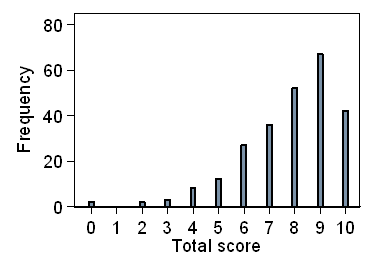
627 + 183 = ?
20 – 3 × 5 = ?
Put these numbers in order of magnitude from smallest to biggest:
0.5 0.03 1 0.1 1.5 0.3 0.55 0.05
0.001 is equal to which of the following?
1 1
1
(a) –––
(b) –––– (c) –––––
10 100 1000
¾ + 0.6 = ?
If y = x – 2, what is the value of x when y = 6?
Write 3.75 million in figures.
√(32 + 42) = ?
What is 2½% of £10?
If cheese is £4.40 per kilogramme, what should I pay for 200 grammes?
The answers are:
627 + 183 = 810
20 – 3 × 5 = 5.
Note that the order of operations in maths is
brackets, powers of, divide, multiply, add, subtract.
Put these numbers in order of magnitude from smallest to biggest:
0.5 0.03 1 0.1 1.5 0.3 0.55 0.05
gives us
0.03 0.05 0.1 0.3 0.5 0.55 1 1.5
0.001 is equal to which of the following?
1 1
1
(a) –––
(b) –––– (c) –––––
10 100 1000
The answer is c.
¾ + 0.6 = 0.75 + 0.6 = 1.35.
I would also accept 1 7/20 or 27/20.
If y = x – 2, the value of x when y = 6 is 8.
Write 3.75 million in figures: 3,750,000.
√(32 + 42) = √(9 + 16) = √25 = 5.
2½% of £10 = £0.25 = 25p.
If cheese is £4.40 per kilogramme, for 200 grammes I should pay £4.40 × 200/1000 = £0.88 = 88p.
If you got 7 or fewer right, then I think you should brush up your maths. You might decide to do it anyway.
We can compare these results with those for 251 previous students. The numbers getting each possible score out of 10 were:
| Score | Count | % |
|---|---|---|
| 0 | 2 | 0.8 |
| 1 | 0 | 0.0 |
| 2 | 2 | 0.8 |
| 3 | 3 | 1.2 |
| 4 | 8 | 3.2 |
| 5 | 12 | 4.8 |
| 6 | 27 | 10.8 |
| 7 | 36 | 14.3 |
| 8 | 52 | 20.7 |
| 9 | 67 | 26.7 |
| 10 | 42 | 16.7 |
We can present this graphically:

Hence 36% students got 7 or less, the score that I suggested meant that they should brush up their maths.
The question which caused most trouble was 2: 20 – 3 × 5 = ?. 59% got this wrong, all giving the answer 85. They got this by first subtracting 3 from 20 then multiplying 17 by 5. The rules of arithmetic are that we multiply before we add. We do not need brackets to make this clear. See part 1 of Brush up your maths.
We asked whether you panicked when you saw all those numbers. 54% said 'yes' to this. Not surprisingly, the panickers did worst, with mean score = 7.4, compared to 8.3 for those who did not panic.
Martin Bland
Back to Brush up your maths main menu.
To Martin Bland's M.Sc. index.
This page maintained by Martin Bland.
Last updated: 10 January, 2012.